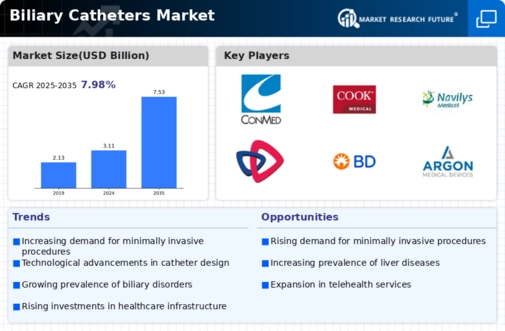Market Analysis
In-depth Analysis of Biliary Catheters Market Industry Landscape
The biliary catheters market is a critical segment within the medical device industry, offering solutions for various biliary tract disorders. Market dynamics in this sector are influenced by factors such as the prevalence of biliary diseases, technological advancements in catheter design, and the growing demand for minimally invasive procedures. This trend in the growing number of biliary diseases such as gallstones biliary strictures, cancers influences the market mechanism negatively. This reflects an increasing demand for biliary catheters performed in diagnostic and therapeutic purposes with the growing rate of such conditions, which conditions the market in the studied period. The market dynamics are significantly impacted by the continual evolution of the biliary catheter design and technology. The innovation resulting in better material, better imaging capabilities, and self-expanding stents contributes to the progress of biliary catheters, changing the treatment results and market rivalry. Demand for minimally invasive procedures leads market movements in biliary catheter categories. The desire for minimally invasive treatments, such as endoscopic and percutaneous procedures using biliary catheters also shapes healthcare cultural and drives market expansion. The market as a whole is affected by biliary catheters that both diagnose and treat. Diagnostic catheters are employed in imaging and visualization of the biliary tract while therapeutic catheters are used in interventions such as drainage, stent placement and removal of stones which affects the adaptability and the demand for these devices. Fluoroscopy and ultrasonographic guidance of biliary catheter procedures is one of the advanced imaging techniques which have been instrumental in the dynamics of the market. These technologies help improve control, precision, and overall safety of catheter implantations, driving demand and proliferation of such procedures. The aggregate global aging population is a contributing factor to the presence of biliary diseases all the while interfering with market dynamics. Among the older population, the occurrence of biliary conditions increases due to which biliary catheters are bought more often; these dynamics are in accordance with the general trends in medicine corresponding to the aging population. Sharp regulatory compliance and uniform biliary catheter designs control market dynamics. The regulatory requirements that manufacturers have to observe among other things affects market entry into markets and the overall product acceptance globally. Market dynamics are influenced by the globalization of the medical device industry. So companies tacitly manipulate themselves to tackle biliary catheter markets in various parts of the world given structural differences found on health infrastructure, regulatory frames, and demographics of the patient populations. The cost-effectiveness and reimbursement policies influence the market dynamics in biliary catheter market. Affordability of interventions and reimbursement back up from health care systems determine the uptake of biliary catheters hence, driving market orientation. There exists a competitive business environment in the biliary catheter market which comes with many rival medical device manufacturers trying to get market share. The fierce competition propels constant clinical trials, product development, and marketing initiatives that yield positive results for both healthcare establishments and individuals in need of a host of choices in devices. The emphasis on patient comfort and improved quality of life contributes to market dynamics. Biliary catheters designed for ease of use, reduced patient discomfort, and improved post-procedure recovery impact the adoption rates and market trends.











Leave a Comment